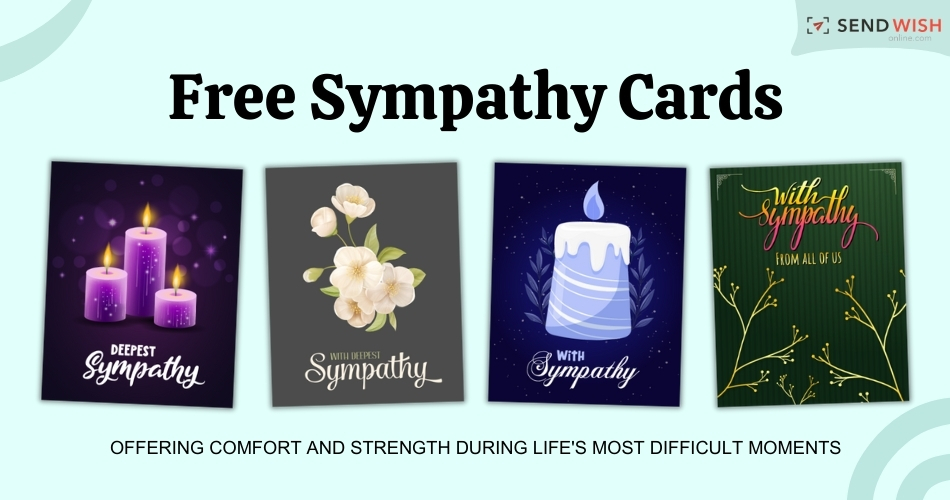Death is inevitable but burying someone’s dream within you is something that no one can prepare one for no matter his or her age. Sympathy cards is one of the techniques of showing a way to console people and offer them their condolences. These cards are an example of how people show their concern, give consolation messages and experiences as a way of expressing that the community is with the grieving persons during their troubled moments. In this article, we present the purpose as to why sympathy cards are essential, further considering what they mean for grieving and how one can choose the best cards.
To further elaborate on why Sympathy Cards are important to give, what can be conveyed through them, and what lessons can be learned from it, I present below the resulting data:
Appreciation brings a lot of comfort when there is a loss and thus taking time to write a sympathy note on a greeting card is very important. Giving Silver Sympathy Flowers to any grieving person is a classic way of showing them that you are with them in their time of loss. Symmetry cards are different from other types of messages received via mail, for example, e-mail or short message service because the cards are unique, romantic, and personal.
Free Sympathy cards provide an important way for people to express their feelings and extend condolences to the bereaved family, and if one is to choose one than any, then the following steps should be followed:
Sympathy card is not when you just pick a card among others and give it to a person who has experienced a loss.
Adding a personal touch such as sharing a memory you have together or even remembering specific needs and concerns they may have that you can help with, personalizes and increases the value of the card.
Appropriate Design: As sympathy cards are mostly bright colored, simple designed cards with burgundy being the most popular color, one should have into consideration the mood of the bereaved as well as the personality of the deceased. If possible, it is better to choose the designs that are of the special interests of the elderly or of their favorite color.
Quality and Material: Select a card produced from materials that would be view as being received with respect, and one that does not easily wear out. Small things such as raised surfaces that have been embossed or materials with foiled or gold lettering help cards to be more classy.
Religious or Non-Religious: Take into account the cultural and religious background of the receiving party as well as the beliefs of the deceased person. There are many versions of sympathy cards with regards to faith that are available in the market and are perfect in conveying the right messages with the right symbols associated to each faith.
Artistic and Poetic Expressions: Some individuals require the different terminologies of sympathy to be incorporated in poetic or artistic forms. Such general topics should be accompanied by quotes, poems, or artworks that would give a card a feeling of positive pieces.
Types of Sympathy Cards
Pity cards exist in all type to fit personal tastes and the type of a relationship that the two people share. Here are some common types:Here are some common types:
Traditional Cards: These cards normally have simple and elegant looks with appropriate and tactful messages or words of condolence.
Handmade Cards: home made cards can be made with bisique and personal messages like pictures or hand written messages embedded in them.
Religious Cards: Items that are religious, for example, cards with pictures, patterns, and messages that read ‘In God’s hands he/she rests’ create comfort for those who believe in the word.
Pet Sympathy Cards: Care givers always love their patients just as much as families love their relatives and thus losing a pet is equivalent to losing a family member or a close friend. Thus it is petition that pet Free sympathy ecards help in acknowledging this grief and extend needed support.
Blank Cards: Occasionally the unsophisticated greeting card permits the sender to not only come up with a unique and distinct greeting but also one that is touching to the receiver.
Share Memories: Can include personal stories and stories or incidences that you have come across regarding the deceased.
Offer Support: Additionally, it is useful to let the recipient know you’re there for them and the concrete ways that you can support them if needed.
End with Comforting Words: The last thing to remember is to close your message with some kind of words that would comfort you, provide you hope or simply offering condolences.
Conclusion
In any kind of loss, sympathy condolence cards play an effective way of cushioning a family that is in receipt of bad news. Selecting the most appropriate sympathy card requires people to put quite some consideration on the part of the card that they prefer and the extent of the relation they had with the deceased. Finally, then, choosing a sympathy card that is traditional or one that is more personal will help express the empathy of the giver and show support during a bad time. When you take your time and make sure to post a heartfelt sympathy card, you are helping to ‘heal’ and are also making a statement in support of those in grieving times.

